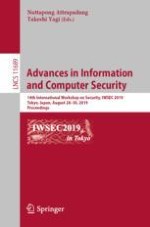2019 | OriginalPaper | Buchkapitel
More Results on Shortest Linear Programs
verfasst von : Subhadeep Banik, Yuki Funabiki, Takanori Isobe
Erschienen in: Advances in Information and Computer Security
Aktivieren Sie unsere intelligente Suche, um passende Fachinhalte oder Patente zu finden.
Wählen Sie Textabschnitte aus um mit Künstlicher Intelligenz passenden Patente zu finden. powered by
Markieren Sie Textabschnitte, um KI-gestützt weitere passende Inhalte zu finden. powered by
